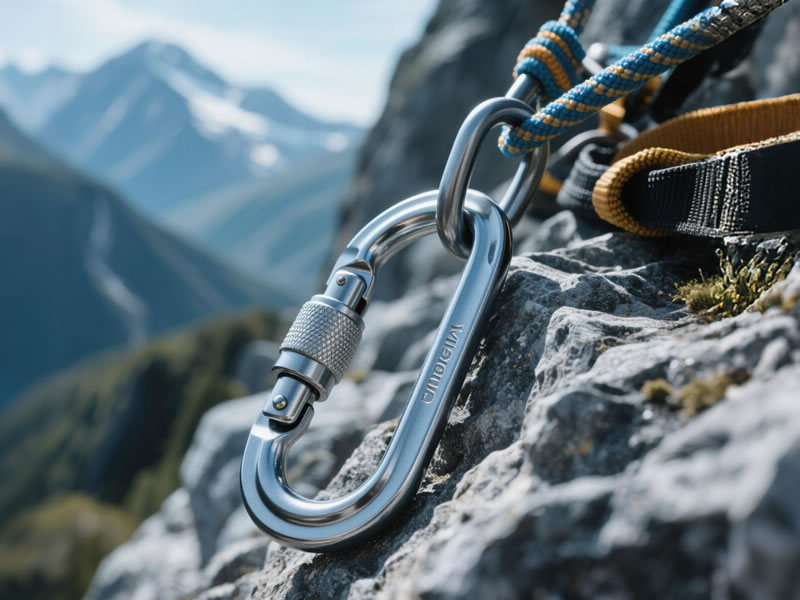Can I use a swivel carabiner for rappelling?
The short answer is yes, you can use a UIAA/EN-certified locking swivel carabiner for rappelling—but it requires strict adherence to safety protocols, and it’s rarely the optimal choice for most scenarios. Understanding the nuances is critical for risk management. Here’s what every climber and rappeller must know.

The Non-Negotiable Requirements
- Certification is Mandatory:Only swivel carabiners certified to UIAA 121 or EN 12275 standards provide guaranteed strength (≥20 kN major axis, ≥7 kN minor axis). Never use uncertified, decorative, or hardware-store swivels.
- Locking Gate Essential:Screwgate (e.g., Black Diamond RockLock) or triple-action locks (e.g., Petzl Am’D Ball Lock) are required. ⚠️ Wiregate swivels are UNSAFE for rappel anchors—they risk accidental opening under rope movement or snagging.
- Correct Attachment Point:Attach only to your belay loop. Never connect to harness tie-in points, gear loops, or daisy chains.
When a Swivel Might Be Useful
Swivels offer one key benefit during rappels: reducing rope twist. This is relevant if:
- You’re using twin/double ropes prone to tangling.
- Rappelling multi-stage routes with complex rope pulls (e.g., traversing descents).
- Preventing knots or hockles in dynamic ropes.
Significant Risks & Drawbacks
- Increased Failure Points:Swivels have moving parts vulnerable to grit, sand, or ice, which can seize the mechanism. A stuck swivel defeats its purpose and may hide internal damage.
- Cross-Loading Vulnerability:In multi-anchor setups, rope tension can force the swivel sideways, creating dangerous minor-axis loading (↓70% strength).
- Weight & Bulk:Swivels add unnecessary mass versus a standard locker—a liability on long alpine descents.
- False Sense of Security:Swivels do not enhance core rappel safety. Misplaced trust in "smooth rotation" distracts from fundamental backup systems.
Best Practices for Safe Use (If Proceeding)
- Inspect Relentlessly:Test swivel rotation before each rappel. Retire immediately if stiff, gritty, or damaged.
- Always Backup:Use a Prusik knot or autoblock below your rappel device. This remains non-negotiable.
- Anchor Connection Caution:If attaching the swivel to an anchor (e.g., master point), ensure it cannot contact sharp edges or cross-load.
- Avoid Extended Use:Swivels wear faster than standard carabiners. Replace after 5 years of frequent use or any impact.
The Verdict: When to Avoid
Standard locking carabiners (screwgate or triple-action) are safer, simpler, and lighter for 95% of rappels. Reserve swivels only for:
- Certified models in excellent condition.
- Complex rope systems where twist is a proven issue.
- Short rappels where you can visually monitor the system.
Critical Alternatives
- Rope Management: Prevent twists by flaking ropes meticulously before rappelling and using rope bags.
- Anti-Twist Devices: Dedicated tools like the Petzl Tandem Twist or Sterling S.C.A.M. solve rope spin without swivel risks.
- Carabiner Orientation: A standard locker on the belay loop + rappel device often rotates sufficiently.
Conclusion
While technically permissible with certified locking swivels, rappelling demands simplicity and reliability. Swivels introduce complexity where it’s rarely justified. Prioritize these steps instead:
- Use a standard UIAA/EN locking carabiner.
- Deploy a Prusik/autoblock backup.
- Flake ropes carefully to minimize twist.
- Inspect all gear pre-rappel.
Swivel carabiners excel in lead-clipping scenarios, but for rappelling, their niche benefit rarely outweighs the risks. When safety margins are thin, fewer moving parts are always better. Stick to the fundamentals—your life depends on it.






